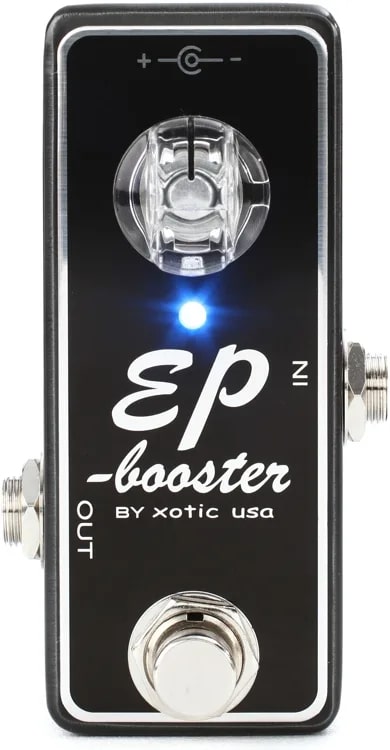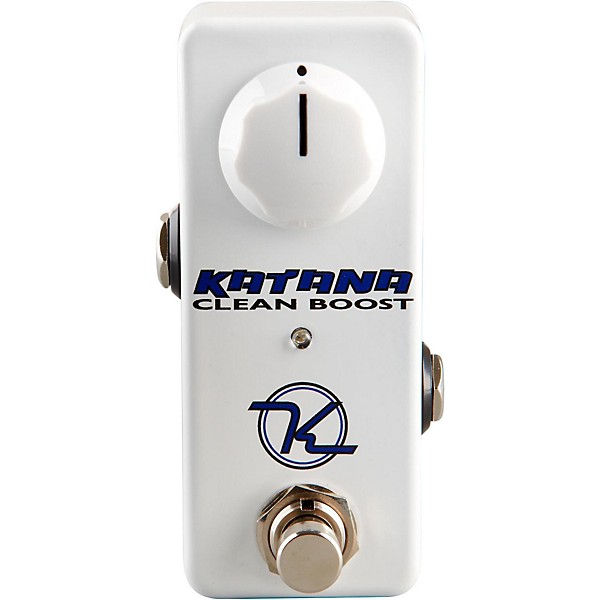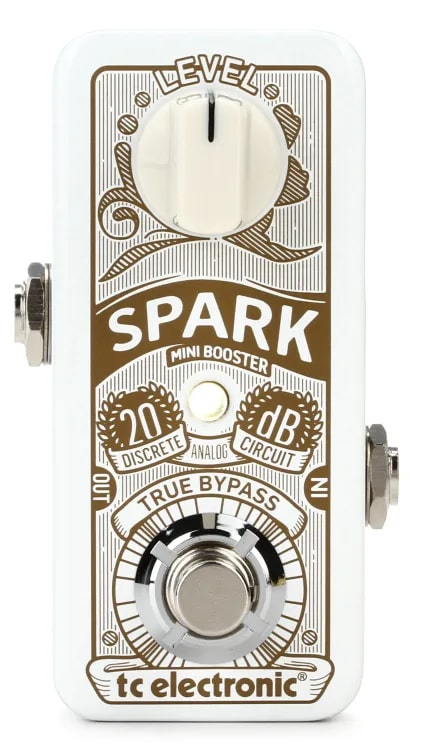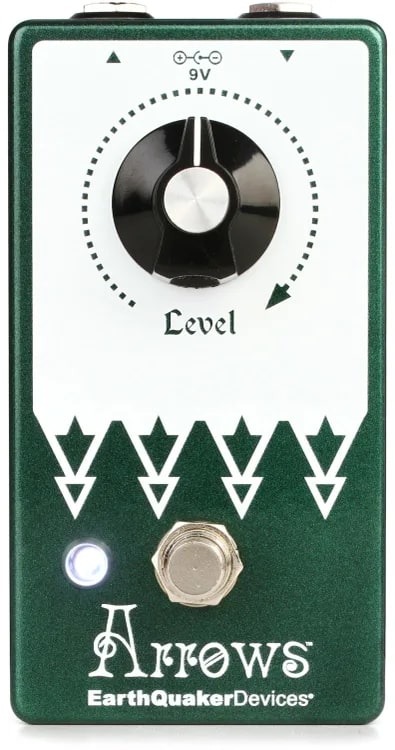When you buy through our links, we may earn an affiliate commission.
Clean boost pedals can be the unsung heroes of your signal chain.
While there are many effects pedals out there that are renowned for how much they can alter your tone, clean boost pedals aim to do just the opposite. The role of a clean boost pedal is to boost the volume of your signal without having a huge effect on your tone.
Sometimes, capturing the natural tone of your guitar is more appealing than trying to alter it. This article outlines the six best clean boost pedals on the market today, so you can find the perfect one for your collection!
The number one spot goes to the Xotic EP Booster Mini since it maintains high quality in every aspect of its construction and performance.
After ranking the pedals, we'll also delve into a buyer's guide and FAQ section. By the end of the article, you'll be an expert on clean boost pedals. Let's get to it!
Check out our picks for clean guitar amps to go with your new boost pedals.
Quick Summary of the Best Clean Boost Pedals
- Xotic EP Booster Mini Boost Pedal (Our Top Choice)
- Keeley Katana Mini Clean Boost Pedal (The Runner-Up)
- TC Electronic Spark Mini Boost Pedal (Most Budget-Friendly Pedal)
- TC Electronic Spark Booster Pedal (Best Pedal for Tone Sculpting)
- EarthQuaker Devices Arrows V2 Preamp Booster Pedal (Best for Live Shows)
- Fender Engager Boost Pedal (Most Versatile)
Best Clean Boost Pedals
1. Our Top Choice – Xotic EP Booster Mini Boost Pedal

SPECS
- Price: $130
- True bypass
When it comes to clean boost pedals, the simpler the better. In essence, these pedals are role players, and if they are good at that one role, then that's all you can ask for.
The Xotic EP Booster Mini Boost Pedal is our choice for the overall best clean boost pedal on the market because it has everything you could want for this piece of gear. It's simple to use, durably built, compact, and best of all, great at its job.
The Xotic EP Mini provides a transparent boost to your signal based on the preamp stage of the classic EP-3 echo effects processor. It delivers up to 20db of boost, which is more than enough to ensure your guitar doesn't get drowned out in the mix.
This pedal is beloved by many guitarists across all genres because it works exactly as it's supposed to. Use it to increase the volume of your guitar without audibly affecting the tonal qualities of the signal.
Compact, lightweight, and straightforward to use, the Xotic EP Mini can quite literally go into any pedalboard. It plays nice with any other pedal that might come before or after it in the signal chain because has such a small effect on the actual tone.
There's no risk in throwing the Xotic EP Mini into your chain because it has true bypass, meaning it will leave your signal completely unaffected when it is switched off. Its small size allows it to fit into a very cramped pedalboard, which is a nice touch as well.
If you do find yourself wanting to make adjustments, there is an internal EQ dip switch, which can cut out certain frequencies from being boosted.
2. The Runner-Up – Keeley Katana Mini Clean Boost Pedal

SPECS
- Price: $99
- True bypass
The Keeley Katana Mini is another fantastic option when it comes to clean boost pedals. Like the Xotic mini, it plays its role well and doesn't complicate things. It's another ideal boost pedal for people who appreciate simplicity and convenience.
The Katana Mini has a small footprint and gives a straightforward boost to your signal, making it suitable for basically any guitar rig.
Whether you have a clean and crisp tone that you want to boost without causing overdrive, or a high-gain tone that just needs to go even louder, the Keeley Katana Mini will help you out. This transparent boost pedal will boost your guitar signal without complicating things.
You can also use its internal dip switches for some subtle EQ control if there's a pesky frequency you don't want boosted. You'll have to take the plate off to access these controls, but chances are you'll be satisfied with the boosted tone it provides right out of the box.
Not much more needs to be said about the Keeley; it's a small, affordable, effective boost pedal that does exactly what you need it to with no unexpected surprises.
3. Most Budget-Friendly Pedal – TC Electronic Spark Mini Boost Pedal

SPECS
- Price: $69
- True bypass
Clean boost pedals aren't known for being particularly expensive, perhaps because they're relatively simple to construct. But if you're looking for the most budget-friendly pedal you can find that won't compromise on quality, then the TC Electronic Spark Mini Boost Pedal is a safe bet.
This pedal retails for $30 - $60 less than other pedals like it, and the internal circuitry is just about the same.
If we're trying to nitpick, we could point out that its plastic casing isn't quite as resilient as the casings of some other pedals out there. But in reality, this shouldn't be a problem. The TC Electric Spark Mini is still plenty durable, and it's one of the most affordable boost pedals you can find.
Get up to 20dB of boost, with true bypass circuitry for when you don't want the pedal active. A mini pedal this effective and cost-efficient is definitely worth looking into.
4. Best Pedal for Tone Sculpting – TC Electronic Spark Booster Pedal

SPECS
- Price: $79
- True bypass
- 2-band EQ
- 3-way characteristic toggle switch
This pedal does more than just provide a clean boost. If you choose to, you can use its dials to sculpt your tone as well.
The TC Electric Spark Booster Pedal is only $10 more than the mini pedal, but it has so many more capabilities. This pedal features a gain knob, level knob, bass knob, and treble knob, as well as a three-way switch to determine the voicing presets.
The TC Electric Spark Booster is a very versatile pedal because you can use it as a clean boost pedal, an overdrive pedal, or an EQ pedal.
After playing around for a bit, you'll be able to find a combination of settings that sounds perfect for your solo or rhythm part. Keep it clean or add just a bit of gain so your guitar really cuts through the mix.
We really love using the TC Electric Spark to add just a bit of grit to a clean tone, giving your guitar parts just a bit more... well, spark!
$79 is also an impressive price for a pedal with this many tone-sculpting capabilities. For those on a budget, you could pick up the TC Electric Spark Booster pedal to do the job of 3 pedals: a clean boost pedal, EQ pedal, and gain pedal.
5. Best for Live Shows – EarthQuaker Devices Arrows V2 Preamp Booster Pedal

SPECS
- Price: $109
- True bypass soft switch
Most clean boost pedals are fundamentally the same and essentially work interchangeably with one another. If all you're after is a boosted signal, then there are multiple contenders that will get the job done.
If you specifically want a pedal that you can switch on and off during live performances, though, then the EarthQuaker Devices Arrows V2 Preamp Booster Pedal is a cut above the rest of the pack.
The main thing that sets this pedal apart is its true bypass switch. The foot switch is a "soft" style, so it won't make a clicking sound when you turn it on or off. It also won't require much force from your foot, making seamless switches a breeze to pull off.
This EarthQuaker pedal is the easiest way to instantly increase your guitar's volume on stage, and there are several reasons you might want to do this.
Let's say you have a verse and chorus that both use the same guitar tone, but you want the chorus to be louder so that the audience feels a burst of energy. With this pedal, you can execute this transition fluidly, without an awkward split-second delay or clicking sound that might result from other boost pedals.
As far as the actual performance of the pedal, it once again proves that a well-made simple boost pedal can be a guitarist's best friend. The boosted tone retains the same tonal qualities as the bypassed tone. The only real difference is, of course, the volume.
The level knob glides fluidly and feels satisfying to turn. This is an all-around great boost pedal that is definitely worth the investment, especially for guitarists who plan to use its foot switch in live-performing environments.
6. Most Versatile – Fender Engager Boost Pedal

SPECS
- Price: $119
- True bypass and buffered bypass
Introducing an impressively versatile boost pedal from a long-trusted brand. The Fender Engager Boost Pedal is the perfect choice for someone who wants to boost their signal as well as fine-tune their tone.
You won't be able to use this pedal to create an entirely new tone for your guitar. Instead, you'll be able to selectively boost or cut out certain frequencies, putting the finishing touches on a tone you already love.
The toggle switch allows you to choose between 400Hz and 800Hz for your midrange frequency. This combined with the bass and treble knobs makes the Fender Engager a powerful little tone shaper.
Being able to fine tune which frequencies get boosted means you'll be able to make your guitar sit perfectly among the other instruments in the mix, without having to fundamentally change your instrument's tone.
As a clean boost device, rather than an overdrive pedal, you usually won't notice any distortion that fundamentally changes your tone. Your shimmery, creamy, or smooth tone will remain relatively unaltered as you give it a little extra life and presence with the Fender Engager Boost Pedal.
At certain settings, you may hear some saturation, a subtle form of distortion that has the effect of making the signal stand out more without sounding overdriven. This can be perfect for guitar that has a great tone but just needs a little extra help competing with the other instruments.
The aluminum casing and LED backlights look sleek and professional. It's also a very durably constructed pedal, perhaps the most durable on this list. It has a magnetic latching battery door to make it quick and easy to switch out the 9V battery.
Unlike most boost pedals, it can switch between true bypass and buffered bypass.
In true bypass, the signal will remain completely unaffected, while buffered bypass will still alter the signal slightly when the pedal is in bypass mode. Most players prefer true bypass, but there are some situations where buffered bypass might be preferable, so it is nice to have the option.
Best Clean Boost Pedals Buyer's Guide
No matter what piece of gear you end up buying, chances are you'll have some criteria you'd like it to meet. Let's look at some of the most important considerations when it comes to choosing a clean boost pedal.
Tone Transparency
All clean boost pedals have the job of providing a volume boost without changing the signal's tonal qualities. Even the pedals with tone-shaping abilities should still be able to be used as a straightforward boost pedal if necessary.
So the most important thing when looking for a piece of gear like this is, does the pedal transparently boost the signal?
The best way to find this out is to test the pedal out for yourself. See what the difference is between the pedal in bypass and the pedal while it's active. The Xotic EP and the Keeley Katana Mini are two examples of pedals that provide a very transparent boost to your signal.
Amount of Boost
Another very important metric for clean boost pedals is how much they can actually boost the signal. This detail is very easy to find because it is usually front and center on the pedal's product specs.
Most pedals offer around 20dB of gain, some as high as 26 dB. This is plenty of gain for most scenarios. In addition, expression pedals will allow you to control how much of an effect (or multiple effects) is applied while playing.
Bypass Type
The two types of bypass are true bypass and buffered bypass, and they each have their own advantages and disadvantages.
Let's start with true bypass, the more common of the two. With true bypass, the signal is routed from the pedal's input jack directly to the output jack, without passing through any circuitry.
With buffered bypass, on the other hand, the signal passes through a buffer circuit when the pedal is in bypass mode.
The advantage of true bypass is that it maintains the tonal qualities of the signal. However, the farther the signal has to travel, the greater the risk of signal degradation.
That's where buffered bypass comes in. Buffered bypass cuts down on signal degradation (theoretically, anyway), but this may come with some slight effects on the signal's tonal qualities.
So, possible signal degradation, or a slightly altered signal? Pick your poison.
Overall, we prefer true bypass because signal degradation doesn't start becoming an issue until you have a high number of cables and pedals in your chain. However, this is all very case-dependent, and there's no wrong answer.
Size & Shape
Each pedalboard can only accommodate so many different pedals, so smaller pedals can be beneficial.
If you are low on space on your pedalboard, then consider going with something like the Xotic EP Mini or the Katana Mini, rather than a full-size pedal like the Fender Engager.
But if you're not short on space, then the size of the pedal truthfully won't matter that much. Most pedals come in standardized sizes anyway.
Budget
Budget is a consideration for any piece of gear you're looking to buy. Fortunately, clean boost pedals are relatively cheap as far as musical gear goes.
For example, the TC Electronic Spark Mini is a great booster pedal for only $70.
If you're looking to go as budget-friendly as possible, then you can always buy used pedals at music shops or on online marketplaces. You might be able to find a pedal for $40 or so.
Whenever you buy used, just keep in mind that it's always better if you're able to test out the product before you buy it, to make sure it works as advertised.
Additional Features
There are many pedals out there that can function as clean boost pedals, EQ pedals, overdrive pedals, or any number of pedals all in one package!
If you need multiple different effects in one pedal, then consider going with the TC Electric Spark, or other pedals that come with unique features.
Individual pedals can start to add up when you're working on a budget, so check out our multi-effects pedals if you're on a budget.
Frequently Asked Questions (FAQs)
Fundamentally, what does a clean boost pedal do?
A clean boost pedal increases the volume of your guitar without affecting its tone.
That said, you may notice some slight shifts in tonal qualities, like more saturation, more fullness, or certain frequencies being highlighted.
What differentiates a clean boost pedal from gain or overdrive pedals?
The fundamental difference is that a clean boost pedal is not intended to cause overdrive or distortion effects. Technically, they still add gain to your signal, but it is a clean type of gain that will not cause any grit in your tone, at least with most amps.
With a tube amp, more gain equals more distortion, so even a clean boost pedal will probably cause your tone to sound more overdriven at a certain point. This depends on your guitar, pedal, and amp settings, though.
Where should I place my clean boost pedal in my signal chain?
Since clean boost pedals are so simple, they will have a similar effect on your signal no matter where you put them in the chain.
That said, it usually makes the most sense to put your clean boost pedal right after your distortion or overdrive pedal. Think about it like this: Since the clean boost pedal is just making the signal louder, it makes sense to put all your tone-shaping effects before it so that they can be transparently boosted as well.
Clean boost pedals are typically placed near the beginning of the chain, while modulation effects like chorus and delay are best placed near the end.
Do clean boost pedals affect my guitar's tone?
While the primary purpose of a clean boost pedal is to affect volume and not tone, there are some cases where these types of pedals will still have an effect on your tone.
In a tube amp, for example, you can boost the signal a lot using your clean boost pedal in the preamp stage, and this will most likely result in more natural tube saturation. Add even more boost and you'll be met with tube distortion or overdrive.
But even with solid state or modeling amplifiers, a clean boost pedal can still create saturation in your tone. Unlike distortion or overdrive, saturation is very subtle, and your tone can still sound clean even with a bit of saturation on it.
Depending on the boost pedal you use, the boosted signal could also sound more shimmery, full, and warm in addition to being louder.
There's no one-size-fits-all answer to this question, but in short, clean boost pedals can have effects on tone. The best way to get in touch with those effects is to mess around with the settings on your clean boost pedal so you can get a feel for how they work.
In Conclusion
Thank you for reading our rankings of the six best clean boost pedals on the market today.
The Xotic EP Booster Mini reigns supreme because it is just so effective, simple, and durable. It's been used in countless studios throughout the world and always gets the job done.
If you've never used a clean boost pedal before, then you'll find that the difference is night and day. Especially if you just feel like your amp or signal chain is lacking something, but you're not sure what. One of the six pedals on this list just might be your answer. Check out our other choices for guitar pedals if you're looking to change up your sound.
